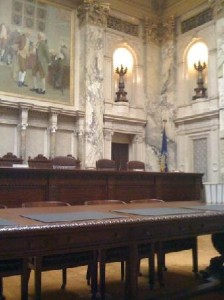The Wisconsin Supreme Court’s Caperton Moment
 The definitive litmus test for the impartiality and competence of the Wisconsin Supreme Court took the form of a lengthy opinion issued in response to the consolidated action State of Wisconsin ex rel. Two Unnamed Petitioners v. Peterson (2015 WI 85) by our state’s highest court on July 16, 2015. They failed this test miserably. In that one day, the court managed to squander the entirety of its judicial capital and to risk making itself into a tribunal that is an insult to the distinguished jurists who have come before them. This is about much more than the unjustified halting of a bipartisan probe into potentially severe violations of Wisconsin’s election laws — it is a prime illustration of the corrosive and corruptive influence that money has on politics and, in particular, judicial politics. These decisions are more misguided and indeed may possibly be more corrupt than the decisions reached by the West Virginia Supreme Court that led to the now-famous United States Supreme Court decision Caperton v. A.T. Massey Coal Co. (556 U.S. 868) and inspired John Grisham’s best-selling novel The Appeal.
The definitive litmus test for the impartiality and competence of the Wisconsin Supreme Court took the form of a lengthy opinion issued in response to the consolidated action State of Wisconsin ex rel. Two Unnamed Petitioners v. Peterson (2015 WI 85) by our state’s highest court on July 16, 2015. They failed this test miserably. In that one day, the court managed to squander the entirety of its judicial capital and to risk making itself into a tribunal that is an insult to the distinguished jurists who have come before them. This is about much more than the unjustified halting of a bipartisan probe into potentially severe violations of Wisconsin’s election laws — it is a prime illustration of the corrosive and corruptive influence that money has on politics and, in particular, judicial politics. These decisions are more misguided and indeed may possibly be more corrupt than the decisions reached by the West Virginia Supreme Court that led to the now-famous United States Supreme Court decision Caperton v. A.T. Massey Coal Co. (556 U.S. 868) and inspired John Grisham’s best-selling novel The Appeal.

